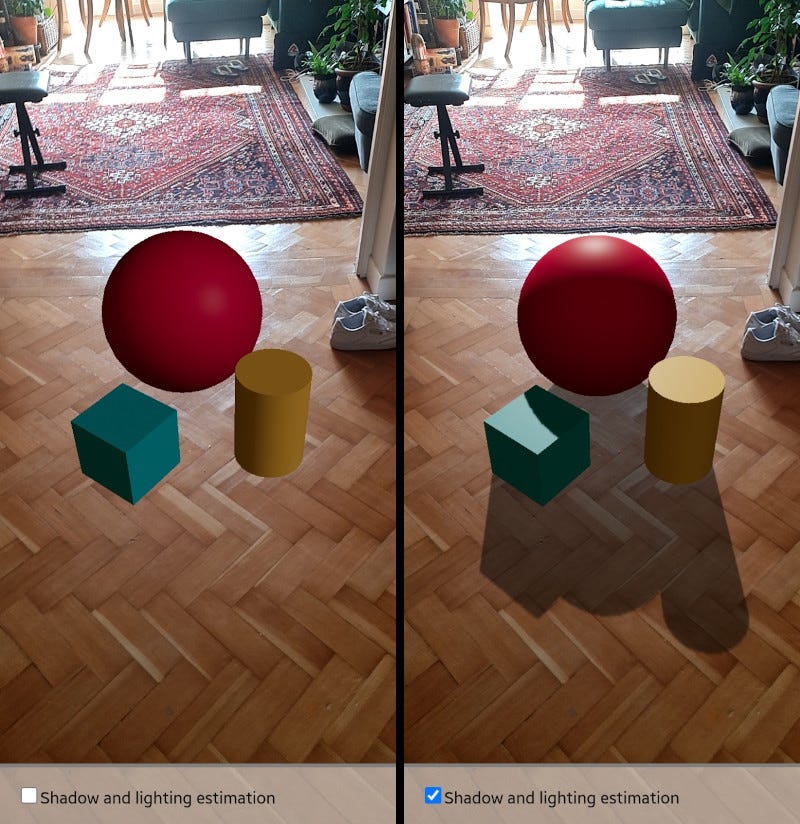Using the WebXR Light Interpretation API we can make 3D objects towards to be physical parts of our real environment by having real lights stupefy virtual objects and virtual objects tossing shadows onto real surfaces.
This vendible will explore how to set it up in AFrame to make your own AR squint really good.

Starting from the standard AFrame Boilerplate:
<html>
<head>
<script src="<https://cdn.jsdelivr.net/gh/aframevr/aframe@0d23f9b21c33ab6821046ce95835492cb84996c5/dist/aframe-master.min.js>"></script>
</head>
<body>
<a-scene>
<a-box position="-1 0.5 -3" rotation="0 45 0" color="#4CC3D9"></a-box>
<a-sphere position="0 1.25 -5" radius="1.25" color="#EF2D5E"></a-sphere>
<a-cylinder position="1 0.75 -3" radius="0.5" height="1.5" color="#FFC65D"></a-cylinder>
<a-plane position="0 0 -4" rotation="-90 0 0" width="4" height="4" color="#7BC8A4"></a-plane>
<a-sky color="#ECECEC"></a-sky>
</a-scene>
</body>
</html>
First we are going to replace the AFrame script with the latest testing one from the AFrame github. Any numbered version without 1.3.0 would moreover work but this has just landed in the lawmaking so a numbered release hasn’t been made yet. You can reprinting the latest version URL from here:
aframe/dist at master · aframevr/aframe
<script src="<https://cdn.jsdelivr.net/gh/aframevr/aframe@0d23f9b21c33ab6821046ce95835492cb84996c5/dist/aframe-master.min.js>"></script>
Next considering we are working with Augmented Reality we need to shrink the various shapes lanugo from over 2 meters to something increasingly reasonable to fit inside an indoor space. We will moreover group them all up with a parent entity to make it easier to alimony them together in AR.
What I did here was to shrink the objects to 0.2 their previous scale and moreover widow a replacement camera at a lower height so it still looks good.
<a-camera position="0 0.4 0" wasd-controls="acceleration:10;"></a-camera>
<a-entity id="objects" scale="0.2 0.2 0.2" position="0 0 -1">
<a-box position="-1 0.5 1" rotation="0 45 0" color="#4CC3D9"></a-box>
<a-sphere position="0 1.25 -1" radius="1.25" color="#EF2D5E"></a-sphere>
<a-cylinder position="1 0.75 1" radius="0.5" height="1.5" color="#FFC65D"></a-cylinder>
</a-entity>
We will use the ar-hit-test component to position our objects. It looks at the rays tint by the user tapping on the screen or pointing in an AR headset to find real world locations to place objects at the real world location the user selected. The AR hit test component is configured on the <a-scene> element.
<a-scene
ar-hit-test="target:#objects;"
webxr
>
This now allows us to place the objects into the real world but still they stand out as unmistakably fake. We need to add lights and shadows to make it fit in. By having them be unauthentic by real world lights and tint shadows on real world objects it really ties it together to increase their believability.
The reflection component on <a-scene> handles the lighting interpretation API and letting objects reflect their environment. It has two parts the component and a directional light it controls, we will add both to the scene.
<a-scene
ar-hit-test="target:#objects;"
webxr
reflection="directionalLight:#real-light"
>
<a-light id="real-light" type="directional" position="1 1 1" intensity="0.5"></a-light>
In AR the light now matches the color, intensity and direction of the main light source in the real world. But it doesn’t tint any shadow on the floor. To set this up we we need to make the light itself tint a shadow and an element for the shadow to fall on.
NB: There is a bug in THREE which prevents the reflection map provided by the WebXR lighting interpretation API showing details on the standard material. So if you would like to have a shiny material which reflects the real world you should make it a phong material instead.
To make the light tint a shadow add light="castShadow:true; shadowCameraAutomatic:#objects;" to the <a-light> . In this configuration the shadowCameraAutomatic property is set to the objects you want the shadow to follow. This ensures upper quality shadows that fit your object plane as the objects, and the light moves around, ensuring shadows protract to work well in dynamic conditions like Augmented Reality.
<a-light id="real-light" type="directional" light="castShadow:true;shadowCameraAutomatic:#objects;" position="1 1 1" intensity="0.5"></a-light>
You still won’t see a shadow considering we need to get our objects to tint a shadow. We will add the shadow component to the #objects so they can tint a shadow on each other.
To tint it onto the floor we need to make a special plane to receive the shadow. There is a special shadow shader in the material which can receive a shadow but is otherwise invisible. We will use this to see the shadow. We will moreover add the shadow component so it can recieve shadows but we will prevent it from tossing shadows itself.
<a-plane id="shadow-plane" material="shader:shadow" shadow="cast:false;" rotation="-90 0 0" width="2" height="2"></a-plane>
Unfortunately this shadow plane will be stuck in place at the starting position so we need to make a small AFrame component to indulge it to follow our objects to exhibit their shadow.
<script>
AFRAME.registerComponent('follow-shadow', {
schema: {type: 'selector'},
init() {this.el.object3D.renderOrder = -1;},
tick() {
if (this.data) {
this.el.object3D.position.copy(this.data.object3D.position);
this.el.object3D.position.y-=0.001; // stop z-fighting
}
}
});
</script>
An object that uses this will sit slightly unelevated a sibling object. We will add it to our plane so that it unchangingly sits under them receiving their shadow.
<a-plane id="shadow-plane" follow-shadow="#objects" material="shader:shadow" shadow="cast:false;" rotation="-90 0 0" width="2" height="2"></a-plane>
We now have the lighting set up nicely but there is one last thing we can set up to increase the realism and that is to setup the tone mapping and to tell AFrame to use the physical model for lighting, set renderer with this configuration on the <a-scene>
<a-scene
reflection="directionalLight:#real-light"
ar-hit-test="target:#objects;"
webxr
renderer="physicallyCorrectLights:true; colorManagement:true; exposure:1; toneMapping:ACESFilmic;"
>
The renderer.exposure property can be tweaked in real time to make the scene lighter and darker as needed.
const scene = document.querySelector('a-scene');
const data = scene.getAttribute('renderer');
data.exposure = 0.5;
scene.setAttribute('renderer', data);I hope this helps you build increasingly realistic AR scenes. The renderer properties are expressly useful for any AR, VR or 2D scene and the will-less shadow camera tracking is very useful when you have objects with shadows moving around.
Integrating Augmented Reality Objects into the Real World with Light and Shadows was originally published in Samsung Internet Developers on Medium, where people are standing the conversation by highlighting and responding to this story.
